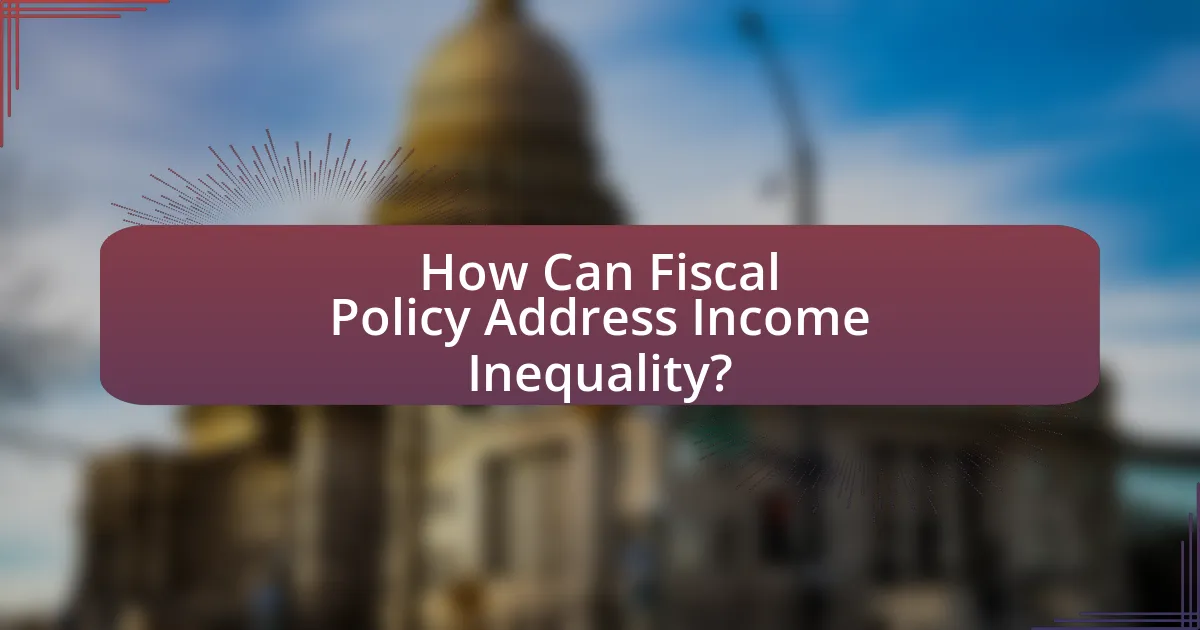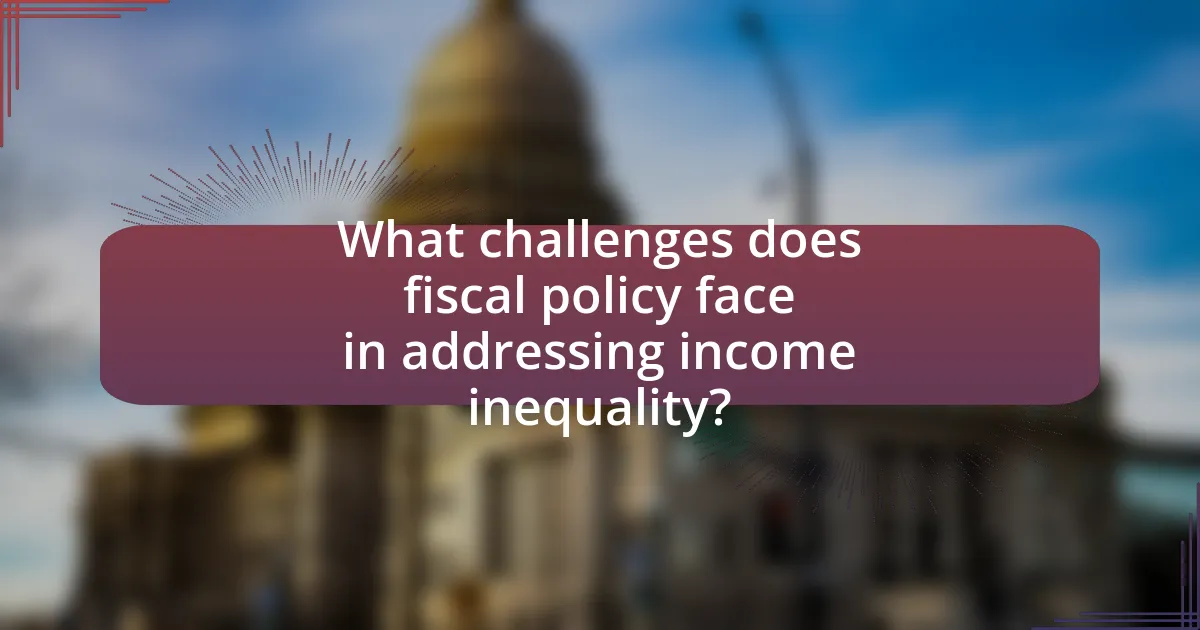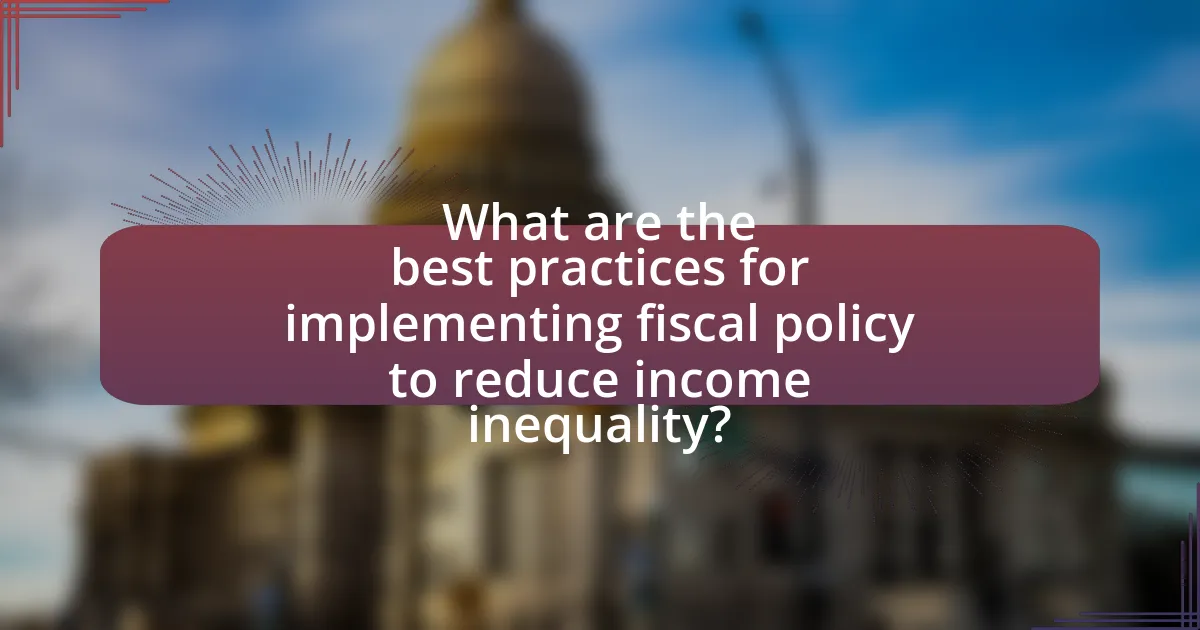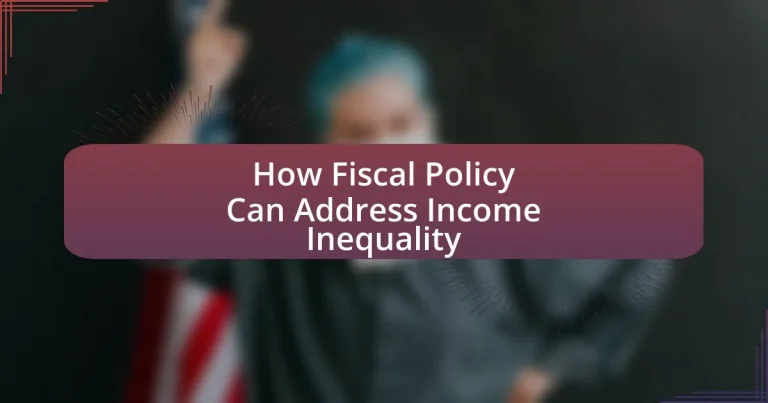Fiscal policy plays a crucial role in addressing income inequality through mechanisms such as progressive taxation and targeted government spending. By imposing higher tax rates on wealthier individuals, progressive taxation redistributes wealth and funds essential social programs that benefit lower-income populations. Key components of fiscal policy, including government spending and taxation, directly influence income distribution and economic stability. The article explores the effectiveness of social welfare programs, the importance of addressing income inequality for social and economic growth, and the challenges faced in implementing fiscal policies. It also highlights best practices and strategies for policymakers to design effective fiscal measures aimed at reducing income disparities.

How Can Fiscal Policy Address Income Inequality?
Fiscal policy can address income inequality through progressive taxation and targeted government spending. Progressive taxation increases tax rates on higher income brackets, redistributing wealth and reducing income disparities. For instance, in the United States, the top marginal tax rate was 37% as of 2021, which helps to alleviate income inequality by taxing higher earners more heavily. Additionally, targeted government spending on social programs, such as education, healthcare, and welfare, directly benefits lower-income individuals and families, improving their economic situation. Research from the International Monetary Fund indicates that countries with more progressive tax systems and robust social safety nets experience lower levels of income inequality.
What are the key components of fiscal policy?
The key components of fiscal policy are government spending, taxation, and budget deficits or surpluses. Government spending involves expenditures on public services and infrastructure, which can stimulate economic growth and influence income distribution. Taxation refers to the methods by which the government collects revenue, impacting disposable income and consumption patterns. Budget deficits occur when expenditures exceed revenues, while surpluses arise when revenues surpass expenditures, both affecting overall economic stability and resource allocation. These components interact to shape economic conditions and can be strategically used to address income inequality by redistributing wealth and funding social programs.
How do taxation and government spending influence income distribution?
Taxation and government spending significantly influence income distribution by redistributing wealth and providing essential services. Progressive taxation, where higher income earners pay a larger percentage of their income in taxes, reduces income inequality by transferring resources from wealthier individuals to fund social programs that benefit lower-income groups. For example, in the United States, the top 1% of earners contribute approximately 40% of federal income taxes, which helps finance programs like Social Security and Medicaid that support lower-income populations. Additionally, government spending on education, healthcare, and welfare programs directly impacts income distribution by improving access to opportunities and resources for disadvantaged groups, thereby promoting a more equitable economic landscape. Studies have shown that countries with higher levels of government spending on social services tend to have lower income inequality, as evidenced by the Nordic countries, which combine high taxation with extensive welfare systems to achieve more balanced income distribution.
What role do social welfare programs play in fiscal policy?
Social welfare programs are essential components of fiscal policy as they directly influence income distribution and economic stability. These programs, such as unemployment benefits, food assistance, and housing subsidies, aim to reduce poverty and support low-income individuals, thereby promoting equitable economic growth. For instance, in the United States, the Supplemental Nutrition Assistance Program (SNAP) lifted approximately 3.1 million people out of poverty in 2019, demonstrating the effectiveness of such programs in mitigating income inequality. By redistributing resources and providing a safety net, social welfare programs enhance consumer spending, which stimulates economic activity and supports overall fiscal health.
Why is addressing income inequality important?
Addressing income inequality is important because it promotes social stability and economic growth. High levels of income inequality can lead to social unrest, decreased consumer spending, and hindered economic mobility. For instance, research by the International Monetary Fund indicates that countries with lower income inequality tend to experience more sustainable economic growth, as equitable income distribution fosters a larger consumer base and increases overall demand. Additionally, addressing income inequality can improve health outcomes and educational opportunities, as individuals in lower income brackets often face barriers to accessing quality healthcare and education, which perpetuates the cycle of poverty.
What are the social implications of income inequality?
Income inequality has significant social implications, including increased social unrest and reduced social mobility. Research indicates that societies with high levels of income inequality often experience higher rates of crime and violence, as marginalized groups may resort to illegal activities due to lack of opportunities. Additionally, income inequality can lead to decreased trust in institutions and government, as individuals feel disenfranchised and believe that the system favors the wealthy. A study by the International Monetary Fund found that income inequality negatively impacts economic growth and social cohesion, further exacerbating divisions within society. These factors collectively contribute to a cycle of poverty and inequality, making it difficult for lower-income individuals to improve their circumstances.
How does income inequality affect economic growth?
Income inequality negatively affects economic growth by limiting access to resources and opportunities for lower-income individuals, which in turn reduces overall consumption and investment in the economy. Research indicates that countries with high levels of income inequality experience slower economic growth rates; for instance, a study by the International Monetary Fund found that a 1% increase in income inequality can lead to a decrease in GDP growth by approximately 0.08% to 0.1% annually. This occurs because when wealth is concentrated in the hands of a few, the majority of the population has less purchasing power, leading to decreased demand for goods and services, which stifles economic expansion.
What strategies can fiscal policy implement to reduce income inequality?
Fiscal policy can implement progressive taxation, increased public spending on social services, and targeted transfer payments to reduce income inequality. Progressive taxation ensures that higher income earners pay a larger percentage of their income in taxes, which can redistribute wealth more equitably. For example, countries with progressive tax systems, such as Sweden, have lower income inequality as measured by the Gini coefficient. Increased public spending on education, healthcare, and housing can provide essential services to lower-income individuals, improving their economic opportunities. Additionally, targeted transfer payments, such as unemployment benefits and social security, directly support those in need, helping to lift them out of poverty and reduce income disparities. These strategies collectively contribute to a more equitable income distribution.
How can progressive taxation help in reducing income disparities?
Progressive taxation can help reduce income disparities by imposing higher tax rates on individuals with higher incomes, thereby redistributing wealth more equitably across society. This system ensures that those who can afford to contribute more to public finances do so, which can then be used to fund social programs, education, and healthcare that benefit lower-income individuals. For instance, according to the OECD, countries with progressive tax systems tend to have lower levels of income inequality, as these systems effectively narrow the income gap by providing essential services and support to disadvantaged populations.
What are the effects of increased government spending on low-income households?
Increased government spending positively impacts low-income households by providing essential services and financial support. This spending often includes social programs such as food assistance, housing subsidies, and healthcare, which directly alleviate poverty and improve living standards. For instance, the U.S. government’s Supplemental Nutrition Assistance Program (SNAP) has been shown to lift millions of families above the poverty line, demonstrating the effectiveness of targeted fiscal policies. Additionally, increased government investment in education and job training programs enhances employment opportunities for low-income individuals, contributing to long-term economic mobility. Studies indicate that every dollar spent on education can yield significant returns in terms of increased earnings and reduced reliance on social services, further validating the positive effects of government spending on this demographic.
How can fiscal policy be evaluated for its effectiveness in addressing income inequality?
Fiscal policy can be evaluated for its effectiveness in addressing income inequality by analyzing changes in income distribution metrics, such as the Gini coefficient, before and after the implementation of fiscal measures. For instance, studies have shown that progressive taxation and targeted social spending can significantly reduce income disparities; the OECD reported that countries with progressive tax systems have lower Gini coefficients compared to those with regressive systems. Additionally, evaluating the impact of fiscal policies on poverty rates and access to essential services provides concrete evidence of their effectiveness in promoting equity.
What metrics can be used to measure the impact of fiscal policy on income inequality?
Metrics that can be used to measure the impact of fiscal policy on income inequality include the Gini coefficient, income share ratios, and poverty rates. The Gini coefficient quantifies income distribution within a population, where a value of 0 represents perfect equality and a value of 1 indicates maximum inequality. Income share ratios, such as the share of income held by the top 10% versus the bottom 10%, provide insights into the disparities created or mitigated by fiscal policies. Additionally, poverty rates reflect the effectiveness of fiscal measures in lifting low-income households, thereby indicating changes in income inequality. These metrics are widely used in economic studies to assess the outcomes of fiscal interventions on income distribution.
How do we assess the long-term effects of fiscal interventions?
To assess the long-term effects of fiscal interventions, economists utilize a combination of econometric modeling, longitudinal data analysis, and comparative case studies. These methods allow for the evaluation of changes in economic indicators such as income distribution, employment rates, and overall economic growth over extended periods following the implementation of fiscal policies. For instance, studies like the one conducted by the International Monetary Fund in 2014 demonstrated that progressive taxation and targeted social spending can significantly reduce income inequality over time, providing empirical evidence of the effectiveness of fiscal interventions.

What challenges does fiscal policy face in addressing income inequality?
Fiscal policy faces significant challenges in addressing income inequality, primarily due to political constraints, economic inefficiencies, and the complexity of implementation. Political constraints often arise from differing ideologies regarding taxation and government spending, which can hinder the enactment of progressive tax policies that aim to redistribute wealth. Economic inefficiencies, such as the potential disincentives for work and investment created by high tax rates, can also limit the effectiveness of fiscal measures. Furthermore, the complexity of implementing targeted programs, such as social safety nets or subsidies, can lead to bureaucratic delays and misallocation of resources, ultimately undermining the intended impact on reducing income inequality.
What political factors influence fiscal policy decisions?
Political factors that influence fiscal policy decisions include the ideological orientation of the governing party, the composition of the legislature, and public opinion. The governing party’s ideology shapes priorities, such as whether to prioritize social welfare or tax cuts, impacting fiscal policy direction. For instance, left-leaning parties typically advocate for increased government spending on social programs, while right-leaning parties may focus on reducing taxes and government size. The composition of the legislature affects the ability to pass fiscal measures; a divided legislature may lead to gridlock, hindering policy implementation. Additionally, public opinion can pressure policymakers to adopt certain fiscal policies, as seen in instances where voter support for social programs influences budget allocations. These factors collectively determine the effectiveness and focus of fiscal policies aimed at addressing income inequality.
How do public opinions shape fiscal policy regarding income inequality?
Public opinions significantly shape fiscal policy regarding income inequality by influencing political agendas and legislative priorities. When a majority of the population expresses concern over income disparity, policymakers are more likely to propose and implement progressive tax reforms, social welfare programs, and public spending initiatives aimed at reducing inequality. For instance, surveys indicate that in the United States, a substantial portion of the electorate supports higher taxes on the wealthy to fund social services, which has led to discussions around policies like the Green New Deal and expanded healthcare access. This correlation between public sentiment and policy action is evident in historical contexts, such as the New Deal era, where widespread public demand for economic reform prompted significant government intervention to address inequality.
What are the implications of lobbying on fiscal policy outcomes?
Lobbying significantly influences fiscal policy outcomes by shaping legislation and budgetary priorities to favor specific interest groups. This influence can lead to tax breaks, subsidies, or regulatory changes that disproportionately benefit wealthy individuals or corporations, thereby exacerbating income inequality. For instance, research by the Center for Responsive Politics shows that industries with higher lobbying expenditures, such as finance and pharmaceuticals, often secure favorable tax policies that contribute to wealth concentration. Consequently, the implications of lobbying on fiscal policy can result in a misallocation of resources, undermining the effectiveness of fiscal measures aimed at reducing income inequality.
What economic constraints limit fiscal policy effectiveness?
Economic constraints that limit fiscal policy effectiveness include high public debt levels, inflationary pressures, and structural economic issues. High public debt can restrict government spending capacity, as servicing debt takes precedence over new investments or social programs. Inflationary pressures can erode the real value of fiscal interventions, making them less effective in stimulating demand. Structural economic issues, such as labor market rigidities and low productivity, can hinder the transmission of fiscal measures into actual economic growth, thereby reducing their impact on income inequality. For instance, countries with high debt-to-GDP ratios often face challenges in implementing expansive fiscal policies, as seen in Greece during the Eurozone crisis, where austerity measures limited fiscal effectiveness.
How do budget deficits impact fiscal policy options?
Budget deficits limit fiscal policy options by constraining government spending and increasing borrowing costs. When a government runs a budget deficit, it must finance its shortfall through debt, which can lead to higher interest rates and reduced public investment. For instance, according to the Congressional Budget Office, persistent budget deficits can crowd out private investment, as government borrowing competes for available funds in the financial markets. This situation restricts the government’s ability to implement expansionary fiscal policies aimed at addressing income inequality, such as funding social programs or infrastructure projects that benefit lower-income populations.
What role does inflation play in fiscal policy effectiveness?
Inflation significantly impacts the effectiveness of fiscal policy by influencing government spending and tax revenues. When inflation rises, the real value of government debt decreases, potentially allowing for increased public spending without raising taxes. However, high inflation can also erode purchasing power, leading to reduced consumer spending and lower economic growth, which can undermine fiscal policy objectives aimed at addressing income inequality. Historical data from the 1970s shows that periods of high inflation often resulted in increased social spending, but also highlighted the challenges of maintaining effective fiscal policy in an inflationary environment.

What are the best practices for implementing fiscal policy to reduce income inequality?
The best practices for implementing fiscal policy to reduce income inequality include progressive taxation, targeted social spending, and investment in education and healthcare. Progressive taxation ensures that higher income earners contribute a larger percentage of their income, which can be used to fund social programs that benefit lower-income individuals. For instance, countries like Sweden and Denmark have successfully utilized progressive tax systems to finance extensive welfare programs, resulting in lower income inequality as measured by the Gini coefficient. Targeted social spending, such as direct cash transfers or subsidies for low-income families, can effectively lift individuals out of poverty and reduce disparities. Research from the International Monetary Fund indicates that well-designed social safety nets can significantly decrease income inequality. Additionally, investing in education and healthcare improves access to opportunities for disadvantaged groups, fostering long-term economic mobility and reducing inequality. Studies show that countries with strong public education systems and universal healthcare tend to have lower levels of income inequality.
How can policymakers design effective fiscal policies?
Policymakers can design effective fiscal policies by implementing progressive taxation and targeted social spending. Progressive taxation ensures that higher income earners contribute a larger percentage of their income, which can reduce income inequality. For instance, countries like Sweden and Denmark utilize high tax rates on the wealthy to fund extensive social programs, resulting in lower income disparity. Targeted social spending, such as direct cash transfers or subsidies for low-income households, can also alleviate poverty and promote economic mobility. Research from the International Monetary Fund indicates that well-designed fiscal policies can significantly reduce income inequality, demonstrating the effectiveness of these approaches in achieving equitable economic outcomes.
What lessons can be learned from successful fiscal policies in other countries?
Successful fiscal policies in other countries demonstrate that targeted taxation and social spending can effectively reduce income inequality. For instance, Scandinavian countries like Sweden and Denmark implement progressive tax systems that redistribute wealth, funding comprehensive welfare programs that provide education, healthcare, and social security. These policies have resulted in lower income disparity, with the Gini coefficient in Sweden at 0.27, indicating a more equitable income distribution compared to countries with less progressive systems. Additionally, New Zealand’s focus on fiscal responsibility and investment in social services has led to improved economic outcomes and reduced poverty rates. These examples illustrate that well-structured fiscal policies can create a more equitable society by addressing the root causes of income inequality.
How can stakeholder engagement improve fiscal policy outcomes?
Stakeholder engagement can improve fiscal policy outcomes by ensuring that diverse perspectives and needs are considered in the policy-making process. Engaging stakeholders, such as community organizations, businesses, and affected individuals, leads to more informed decisions that reflect the realities of those impacted by fiscal policies. For instance, research by the International Monetary Fund indicates that inclusive policy-making can enhance the effectiveness of fiscal measures aimed at reducing income inequality, as it fosters transparency and accountability. This engagement can also build public trust and support for policies, ultimately leading to better implementation and compliance.
What practical steps can individuals take to advocate for effective fiscal policy?
Individuals can advocate for effective fiscal policy by engaging in grassroots organizing, participating in public forums, and communicating with elected officials. Grassroots organizing allows individuals to mobilize community support and raise awareness about fiscal issues, while public forums provide platforms for discussion and debate on fiscal policies. Additionally, direct communication with elected officials through letters, emails, or meetings can influence policy decisions, as representatives often consider constituent opinions when shaping fiscal legislation. Research indicates that active civic engagement can lead to more equitable fiscal policies, as seen in various case studies where community advocacy resulted in policy changes aimed at reducing income inequality.
How can citizens participate in the policymaking process?
Citizens can participate in the policymaking process by engaging in public consultations, attending town hall meetings, and providing feedback on proposed legislation. These activities allow individuals to voice their opinions and influence decision-making. For instance, studies show that public input during the policymaking process can lead to more equitable outcomes, particularly in fiscal policy aimed at addressing income inequality. Engaging with local representatives and participating in advocacy groups further amplifies citizens’ voices, ensuring that diverse perspectives are considered in policy development.
What resources are available for educating the public on fiscal policy issues?
Resources available for educating the public on fiscal policy issues include government websites, educational institutions, and non-profit organizations. Government websites such as the U.S. Department of the Treasury provide comprehensive information on fiscal policy, including reports and data that explain its implications. Educational institutions often offer courses and public lectures on economics and fiscal policy, enhancing understanding through academic research and expert insights. Non-profit organizations like the Economic Policy Institute and the Brookings Institution publish accessible reports and articles that analyze fiscal policy’s impact on income inequality, making complex topics understandable for the general public. These resources collectively contribute to a well-rounded education on fiscal policy issues.





